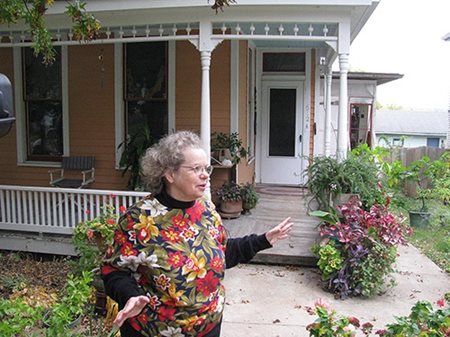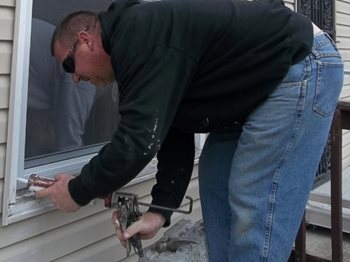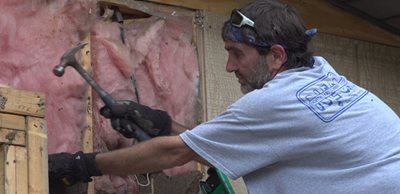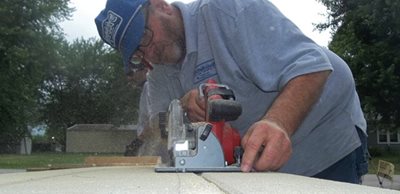Hilly Jacklin had wanted to own a house for years, and the one she finally found was beyond her wildest dreams: a Victorian-style duplex, built in 1895, in Hannibal, Missouri. Half, she would be able to rent to help her afford the mortgage. The other side, she would live in herself.
There were a couple of drawbacks, she says, and they showed themselves when the weather got colder. "It was a really drafty house," she says. "When the wind would blow in the wintertime, if I hadn't put plastic on the window, the curtains would billow out. The kitchen was unbelievably cold. And the heating bills!"
 Jacklin layered up in big, bulky sweaters. And she did something else: She got on the weatherization waiting list for Northeast Community Action Corporation (NECAC), a NeighborWorks Organization. They came and did a "blow test," sealing the house and finding the leaks. They blew insulation in the walls and added door sweeps and re-glazed the windows. They made the house more energy efficient by replacing her old refrigerator and lightbulbs.
Jacklin layered up in big, bulky sweaters. And she did something else: She got on the weatherization waiting list for Northeast Community Action Corporation (NECAC), a NeighborWorks Organization. They came and did a "blow test," sealing the house and finding the leaks. They blew insulation in the walls and added door sweeps and re-glazed the windows. They made the house more energy efficient by replacing her old refrigerator and lightbulbs.
When they were done, she says, "my energy bill was cut in half or more. Now I can heat the entire house for around $700 for the whole winter." Jacklin, who lives on her social security checks, says it had been a real struggle to pay utilities.
"I could tell the difference immediately," she says. "I didn't feel the need to be bundled up in a big sweater all of the time. Now that my utility bills are so much lower it means I don't apply for energy assistance to help with heating and cooling bills and groceries are easier to afford so I don't use the food pantry anymore. I'm making it on my own now thanks to the weatherization program. It really has been lifechanging."
Over the years since she participated in the program, she's directed other people toward NECAC. And members of the nonprofit say they want to have her testify before Congress someday, she's so passionate about speaking about the need for weatherization.
 October is National Weatherization Month. Since the start of Fiscal Year 2008, 27 NeighborWorks Organizations have been providing services to residents through grants from the Department of Energy's Weatherization Assistance Program (WAP). They help people like Jacklin save money and energy through these and other programs. And they talk to residents about things they can do themselves, while waiting for an energy audit.
October is National Weatherization Month. Since the start of Fiscal Year 2008, 27 NeighborWorks Organizations have been providing services to residents through grants from the Department of Energy's Weatherization Assistance Program (WAP). They help people like Jacklin save money and energy through these and other programs. And they talk to residents about things they can do themselves, while waiting for an energy audit."This is really important work to do," says NeighborWorks' Clare Rosenberger, director of real estate programs. "Our groups are so well situated to do this because they're trusted organizations in their communities. They're here to support those community members by helping them increase the durability and livability of their largest investment."
Brent Engel, public relations officer with NECAC, says weatherization is important because it improves the efficiency of a home. "It also makes the houses last longer." NECAC does between 200 and 300 jobs a year, though the waiting list is currently 500 people long, over 12 Northeast Missouri counties.
"Whether it's cold air going out in summer or hot air going out in the winter, that's like dollar bills just going out your windows or out your doors," says Carla Potts, deputy director of NECAC. She has been with NECAC for 43 years. "It's important to make sure everything is as energy efficient as possible through every season."
 Minimizing heat loss as we head into the colder months of the year is key, Rosenberger adds, "especially as many of us find ourselves home for longer periods. Small DIY projects that help reduce drafts and lower energy bills include installing weatherstripping by doors and hanging heavier curtains."
Minimizing heat loss as we head into the colder months of the year is key, Rosenberger adds, "especially as many of us find ourselves home for longer periods. Small DIY projects that help reduce drafts and lower energy bills include installing weatherstripping by doors and hanging heavier curtains." Potts says that over the years, NECAC's program has grown in expertise. They encourage those applying for energy audits to apply for weatherization.
This year, things slowed when COVID-19 kept the staff at a distance, which meant there was a month of staying out of people's homes. In May, they began work again, following CDC protocols. Missouri winters are varied, Potts says. Some go below zero; others remain in the 30s or 40s. "If you don't like the weather now," they like to say, "just wait."
But while the staff is back to full speed, there are other delays. "It's tough to get furnaces right now," Engel says. "We're hearing the wait is anywhere from four to six months" because factories temporarily shut down.
Some things that residents can do themselves while they're waiting for professional weatherization help include:
- Caulking
- Taking a homeownership class to learn about energy tips
- Change furnace filters on regular basis
- Cover windows with plastic. "If you can feel air coming in, air is going out, too," Potts says.
When Potts' department does an energy audit, they start with a blower door test, that pinpoints spots where air escapes. "It's about energy efficiency, but it's also about health and safety," she says. "We go into many homes where the heating system is in bad shape and we need to replace it."

Potts says her organization got into the weatherization program during the height of the energy crisis, "when we knew how our clients were struggling to pay their bills. We knew we had to do something for them, but also for the environment, to reduce our energy load."
Potts says that for organizations with a goal of reducing their carbon footprint, "weatherization does that very well." To start, she suggests contacting the Department of Energy to find out more about the program. "And then reach out to someone who has been in it for years and can provide the contacts to get employees the kind of training and skills they need.
"Talk to others and build from what others have done," she says. "Then make your own stamp on the
program."
The Low Income Home Energy Assistance Program (LIHEAP) may be able to help you pay your home energy bill. Visit NEADA's website to learn more about LIHEAP programs in your state.

